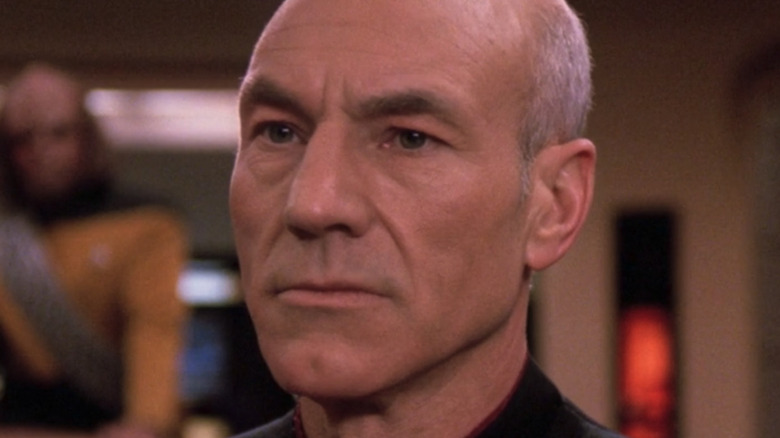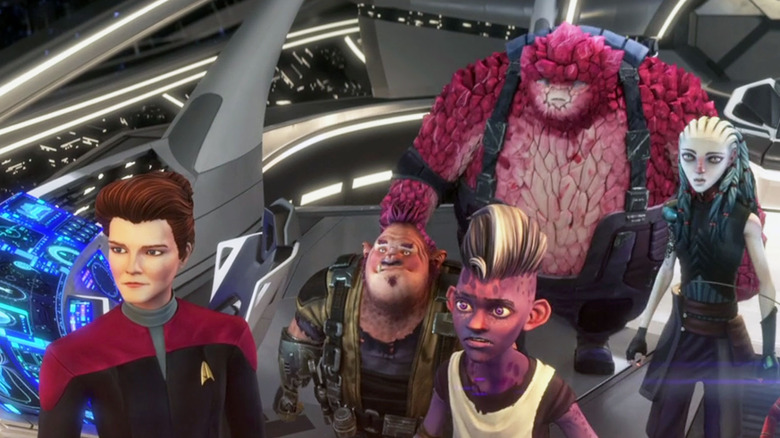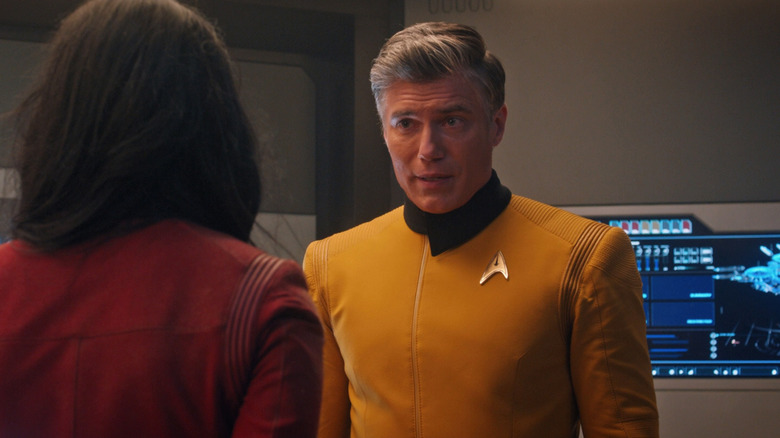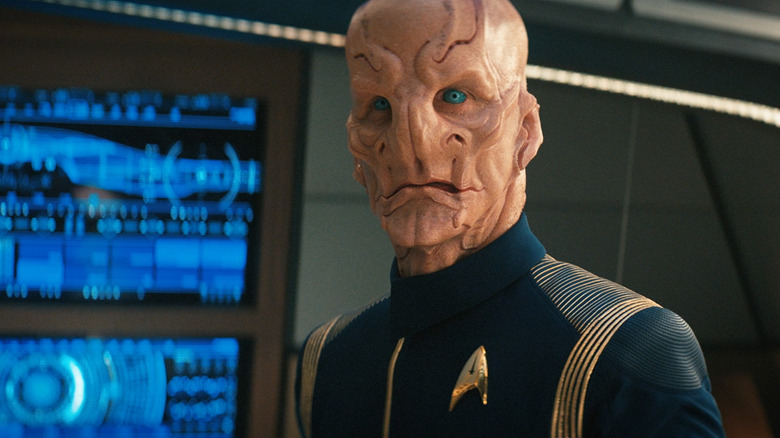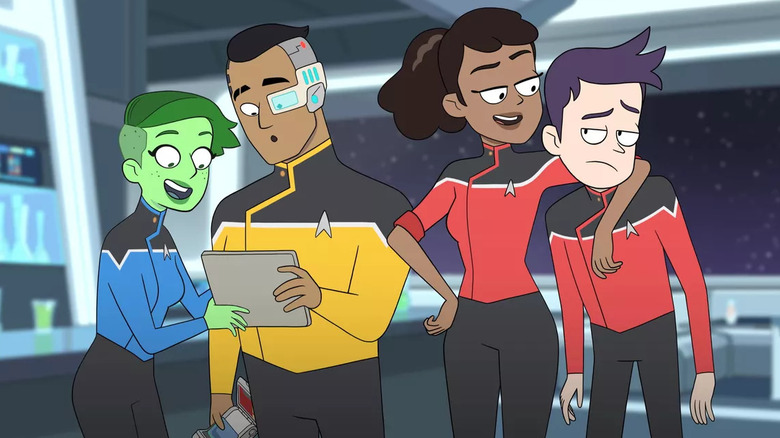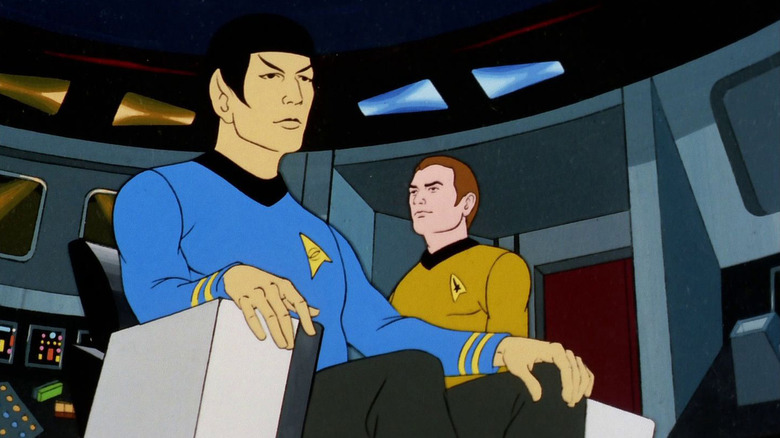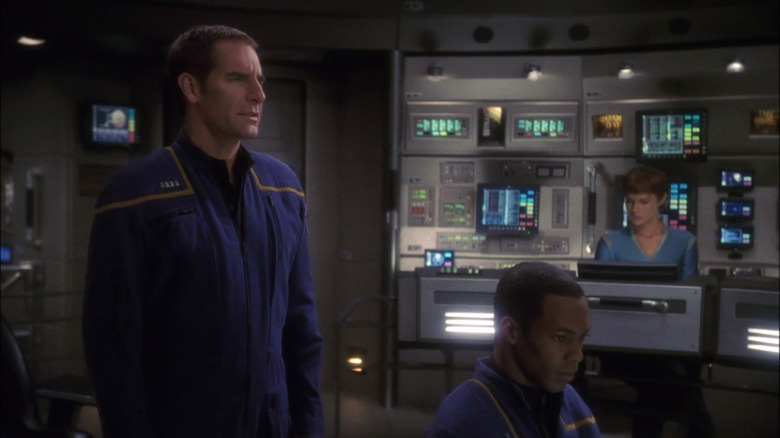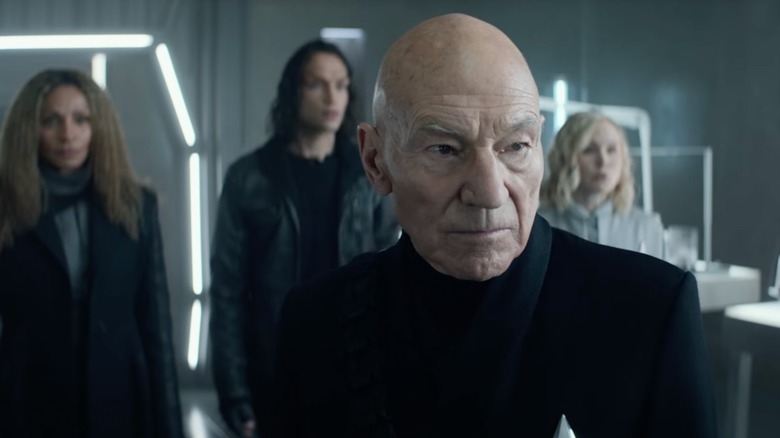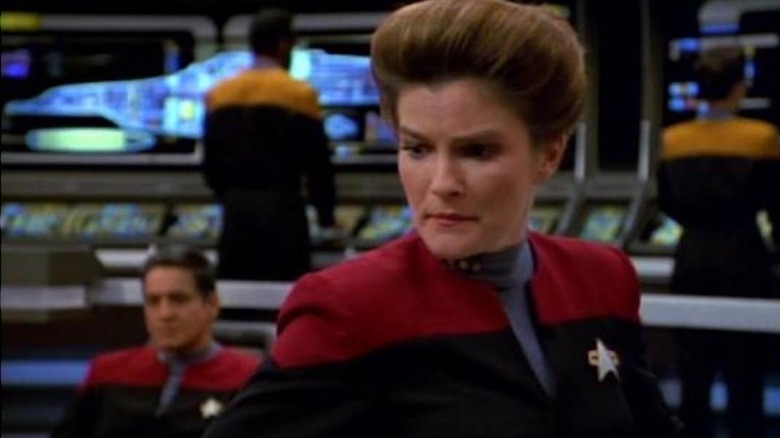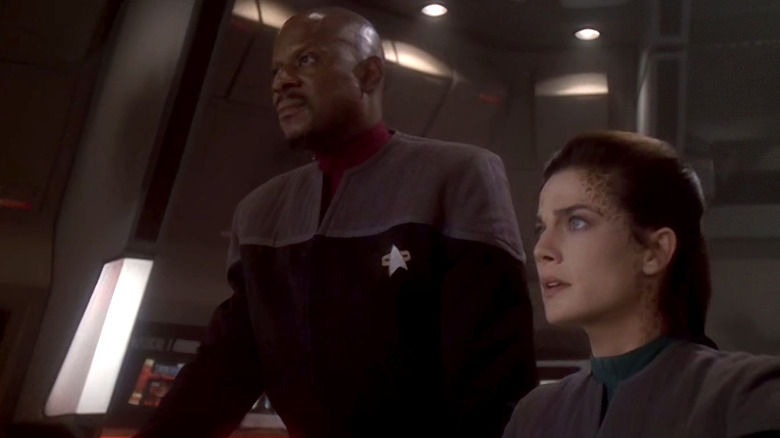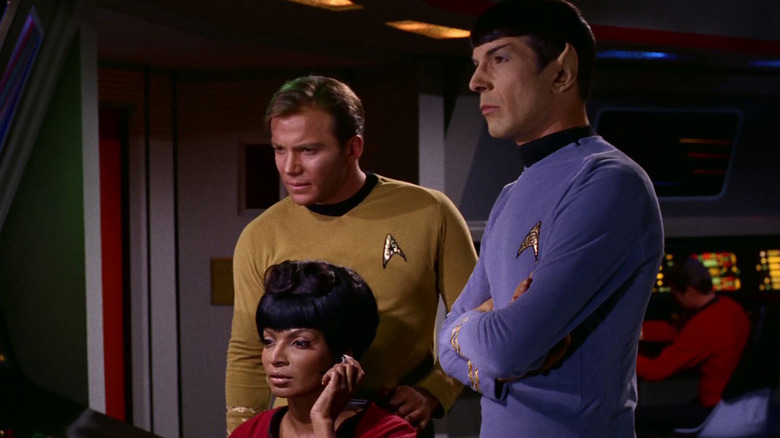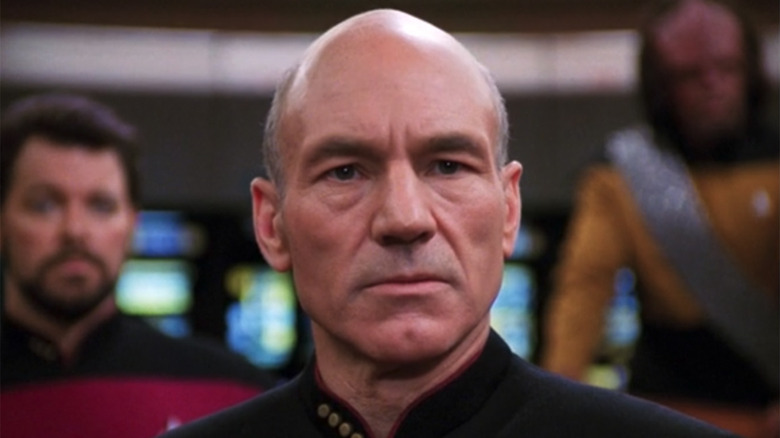Every Star Trek Series Ranked According To IMDb
Before 1987 there were just two series in the "Star Trek" franchise: the original live-action "Star Trek" starring William Shatner, and the short-lived, little-seen children's animated series from the mid-1970s. By 2001 though, that number had tripled with "The Next Generation," "Deep Space Nine," "Voyager," and that year's debut of "Enterprise." Today it's nearly doubled that number, as "Star Trek" is more popular than ever with no fewer than four series currently airing, mostly produced exclusively for the Paramount+ streaming service.
A true cultural phenomenon, the many "Star Trek" series have ranged from upbeat adventures to dark somber stories to wacky adult cartoons. Many shows in the franchise have included characters that have become imbedded in popular culture, and in its nearly 60-year history, "Star Trek" has become perhaps the most well-known science fiction franchise ever created. It's influenced everything from "Star Wars" to the MCU, and with a new series, "Strange New Worlds," debuting in May, there's no end in sight. But how do the rest of the "Star Trek" series rate? A few have gone on to become legendary, a few forgotten, but all of them rate fairly highly. Think you know which one is the best of them all? Think again, because the number one-ranked series may just surprise you.
11. Star Trek: Prodigy
The latest in the pantheon of "Star Trek" series, the animated "Star Trek: Prodigy" is produced by Nickelodeon, and premiered on Paramount+ in September 2021. Centered around a ragtag group of alien teens who escape from a slave colony in the Delta Quadrant after stumbling across a highly advanced and experimental derelict Starfleet ship — the U.S.S. Protostar — the series also sees the return of actress Kate Mulgrew to the franchise. Appearing here as the voice of "Hologram Janeway," a computerized ship's assistant modeled after "Star Trek: Voyager" Captain Kathryn Janeway, she helps guide the young crew of the Protostar as they venture out into space attempting to escape the villainous Diviner, all while hoping to find the United Federation of Planets.
A mix of action, adventure, and time-tested "Star Trek" ideals of exploration and discovery, the series has proven to be just as enjoyable for adult viewers as it has been for kids. Full of hard science, classic "Trek" tropes, moral dilemmas, an optimistic tone, and surprises for casual and diehard fans alike, it also features many unexpected connections to the wider "Star Trek" universe with heroes and villains that longtime Trekkies have been hoping to see return. Though it has the lowest score on this list for now, we suspect this one may just jump up a few spots if it continues to impress as much as the first half-season has.
10. Star Trek: Short Treks
Launched in October 2018 to help tide fans over during the prolonged gap between seasons 1 and 2 of "Star Trek: Discovery" — which lasted nearly a full year — the first season of "Short Treks" was added to CBS All Access monthly in the lead-up to the second season of "Discovery." A series of short episodes ranging anywhere from eight to 19 minutes in length, they often told self-contained vignettes for individual members of the crew. In a few instances, such as "The Brightest Star," that focused on Discovery's Kelpian first officer Saru, the short gave added context to an upcoming episode of its sister series and helped flesh out the larger storyline.
The second season of "Short Treks" streamed sporadically in the fall and winter of 2019 and into January 2020, just before the first season of "Star Trek: Picard" launched. With more varied stories, the second batch of shorts included a prequel to "Picard" that gave important backstory, plus a pair of possible teases for the upcoming "Strange New Worlds" series set aboard the U.S.S. Enterprise and featuring Captain Pike, Mr. Spock, and Number One. There was also something new for "Trek": a fully CGI-animated episode about a little girl who dreams of a legendary folk tale. Ultimately the quality of the episodes varied and it had a spotty release schedule, so while the episodes were generally well received, the series may have frustrated some viewers due to its lack of consistency.
9. Star Trek: Discovery
The first new "Star Trek" series in 12 years, "Star Trek: Discovery" was created by Bryan Fuller (a producer on "Star Trek: Voyager" in the 1990s who had since gone on to create several hit shows, including "Hannibal"), and launched later than expected in fall 2017 after a turbulent production (via The Verge). Produced by Bad Robot and Alex Kurtzman, the series starred Sonequa Martin-Green as Michael Burnham, a troubled Starfleet officer who is found guilty of mutiny, but saved from life in prison when she is re-assigned to an experimental new starship that needs her expertise, the U.S.S. Discovery.
Powered by an advanced new engine that allows it to jump anywhere in the galaxy instantaneously, the Discovery finds itself fighting on the front lines of the Klingon war just 10 years prior to the original "Star Trek" series. Though a lavishly produced series with a stellar cast (that included Jason Isaac, Anthony Rapp, Wilson Cruz, and Michelle Yeoh), the series proved divisive right from the start, visually reimagining many of the franchise's most iconic elements, and telling darker, more mature stories than fans were used to. A change in direction in the second season ended the Klingon war storyline that had kicked off the series and saw the introduction of the U.S.S. Enterprise, along with Captain Pike (here played by "Hell on Wheels" star Anson Mount), and Mr. Spock (Ethan Peck). For its third season, the show was entirely retooled, sending the ship a thousand years into the future where the Federation is a shadow of its former self.
8. Star Trek: Lower Decks
After the franchise successfully returned to episodic television with "Star Trek: Discovery," Paramount switched gears and produced a second series to air on Paramount+ (then called CBS All Access). This new show, "Star Trek: Lower Decks," was an animated comedy aimed at adults from the mind of Mike McMahan, a writer for the hit animated sci-fi comedy "Rick & Morty." Its title an homage to an episode of "Star Trek: The Next Generation" that focused on lower-ranked officers, "Lower Decks" likewise centers on a group of ensigns aboard the U.S.S. Cerritos, a run-of-the-mill Federation starship that doesn't get the choice missions, and rarely sees action.
The wacky character-based comedy introduced Trekkies to Ensign Boimler and his best friend Ensign Mariner, whose mother was the captain of the ship. Along with Ensigns Rutherford and Tendi, the series follows their many misadventures aboard the Cerritos. The series has also seen the return of now-Captain Riker, aboard the U.S.S. Titan, as well as appearances from Counselor Troi, the immortal trickster Q, "Voyager" helmsman Tom Paris, and many other longtime Trek favorites.
Set in the original "Star Trek" universe, "Lower Decks" is packed with Easter eggs, gags, and plenty of references to classic episodes and even behind-the-scenes in-jokes. Though it has been criticized by some fans for both its juvenile and its very adult sense of humor, it's now heading into its third season as a big success and has been met with good reviews for its offbeat style and loving respect for the franchise.
7. Star Trek: The Animated Series
Produced by cartoon studio Filmation from 1973 to 1974, "Star Trek: The Animated Series" wasn't what fans of the original "Star Trek" had been hoping for when they'd heard rumors of a possible revival of the iconic '60s science fiction series, but it did scratch a certain itch. Running for 22 episodes, it was primarily aimed at kids and produced using Filmation's low-budget style of animation that featured limited movement and stock sequences. Though the animation was substandard, the art itself was faithful to the live-action series, and it featured nearly the entire cast reprising their roles (actor Walter Koenig, who played Chekov, was notable for his absence).
The studio didn't skimp on the writing talent, with episodes written by "Original Series" scribes D.C. Fontana and David Gerrold, as well as sci-fi luminary Larry Niven. As a consolation for not being included in the cast, Koenig also contributed a script, the rather silly episode "The Infinite Vulcan," that featured sentient plant people and a 25-foot-tall clone of Mr. Spock.
A testament to the times, "The Animated Series" was full of odd stories and bizarre characters that could only have played in animation. Though heavily mocked by some, Trekkies have found a soft spot for it over the years, and while it's still debated whether it's truly canon, many key elements from the series have made their way into live action, including Spock's pet sehlat, Kirk's middle name, the character of Robert April, and others referenced on its animated successor, "Lower Decks."
6. Star Trek: Enterprise
Attempting to distinguish itself from previous "Trek" series, "Enterprise" launched in fall 2001 and ditched the "Star Trek" in its title for its first two years. Thanks also to a pop ballad theme song, and the series being set more than 100 years before "Star Trek: The Original Series," fan reaction was not overwhelmingly positive initially. Set aboard an experimental starship called Enterprise capable of traveling at an unheard-of Warp Five, newly minted Captain Archer and his stalwart crew — along with Vulcan advisor T'Pol — ventured out into uncharted space years before the United Federation of Planets existed, in a time when Earth was new to the realm of galactic affairs.
Without much of the advanced technology that "Star Trek" fans took for granted, and no Federation to support them, "Enterprise" was truly set on the frontier. By Season 3, the series added back the "Star Trek" moniker and began a fully serialized season-long story arch that was very much a product of the post-9/11 era, as a new villainous race struck Earth with an unprovoked terrorist attack. While it reinvigorated the series creatively, ratings continued to sag throughout its run (via Trek Today). "24" producer Manny Coto would take over as showrunner in its fourth and final season, overseeing a series of multi-episode arcs that added a much needed sense of drama and deep connections to "Trek" lore, including a memorable two-parter set in the Mirror Universe. Though underrated and is better than many remember it being at the time, "Enterprise" was sadly never able to reach its full potential due to impatient viewership.
5. Star Trek: Picard
While actor Patrick Stewart had never quite closed the door on reprising his iconic role as Captain Picard more than a decade after his last appearance, he never did seem quite keen on the possibility (via IGN). But thanks to a strong pitch from Alex Kurtzman and Michael Chabon, the actor would indeed step back into role he made famous on "Star Trek: The Next Generation" in the 2020 series "Star Trek: Picard." Released to much fanfare, it showed an aging, withered Jean-Luc Picard deep in retirement, consumed by regret and still mourning the death of the android Data. With a bold, unexpected new direction for the character, it threw off many fans who had wanted to see the Captain on the bridge of a starship confidently exploring strange new worlds as he had decades before.
Instead, sparked by the discovery of Data's previously unknown "daughter" Soji, Picard discovers that there may be others like her. Abandoned by Starfleet, Picard assembles a crew of capable misfits — including renegade starship captain Rios, ex-Starfleet officer Raffi, a Romulan outcast named Elnor, and the ex-Borg Seven Of Nine — to unravel the mystery of Data's children. The series was controversial for making major changes to a beloved character, but it still managed to satisfy the fandom with appearances from a number of old favorites. Packed with plenty of surprises and some genuinely heartfelt moments, it was strong enough to earn a second and third season, which was announced to be the entirety of its limited run.
4. Star Trek: Voyager
Following "Deep Space Nine," which was set on a space station, and after "The Next Generation" had migrated to feature films, "Star Trek: Voyager" returned the series to its space exploration roots. Kathryn Janeway — the first woman to lead a series and sit in the captain's chair in the franchise's history — commands the U.S.S. Voyager on a mission to capture a group of Maquis terrorists. But when both ships find themselves catapulted into the far-off Delta Quadrant, more than 75 years away from Earth at maximum warp, they're forced to merge their crews and embark together on the long journey home.
The ship's diverse cast of characters includes a half-Klingon engineer, a Vulcan security chief, and a holographic doctor. Alone and far from the Federation, Janeway and Voyager explore strange new worlds, make allies where they can, and meet dangerous new adversaries like the Kazon, the Hirogen, and the Vidiians. Although some initially knocked it as "TNG-Lite," that proved a short-lived criticism, with the show finding success as a rousing adventure with its own flavor. It was praised by fans for its strong characters, particularly its captain, a trailblazing female who inspired an entire generation of young women.
Of course, "Star Trek: Voyager" introduced a new cast member in its fourth season, the former Borg drone Seven Of Nine. Although Seven was added by studio mandate for needless sex appeal, actress Jeri Ryan and the show's writers embraced the challenge and turned her into one of the most complex, beloved characters in "Star Trek" history. Her enduring popularity would prompt her return in "Star Trek: Picard."
3. Star Trek: Deep Space Nine
A departure from the"Star Trek" formula, "Star Trek: Deep Space Nine" is set aboard a space station orbiting a backwater planet called Bajor and commanded by a disgruntled officer named Benjamin Sisko. Not the ideal captain many expected, Sisko arrives with his son after the death of his wife, ready to resign from Starfleet. But before he can, he is given the impossible task of preparing the Bajorans — whose devastated world has just overcome occupation by the Cardassians — for admittance into the Federation. Matters are complicated when Sisko discovers a wormhole that leads to the Gamma Quadrant, home to the religious prophets that the Bajorans worship. The prophets anoint Sisko their emissary, forcing him into the reluctant role of religious figure.
A very different series than "TNG," "Deep Space Nine" featured an eclectic group of personalities, including an unscrupulous Ferengi bartender, an embittered Bajoran soldier, a grumpy shapeshifting sheriff, and a bright-eyed, centuries-old Trill scientist. Darker and more serious than the upbeat series that it ran alongside, the show explored complex stories with a more grim outlook, culminating in a years-long storyline that saw the Federation at war with an interstellar empire in the Gamma Quadrant.
Exploring themes like terrorism, religion, and the horrors of war, it also featured a number of comedic episodes. While it took a while for many fans to warm up to the series, it's since found renewed love thanks to streaming, and has been voted by some fans who appreciate its gloomier tone and offbeat stories as the best in the franchise.
2. Star Trek: The Original Series
Originally designed to be a Western-type TV series set in outer space, this groundbreaking prime-time science fiction adventure series took to the stars with the U.S.S. Enterprise and its intrepid crew. Together they explored strange new worlds and sought out new life in a series that was like nothing audiences had seen before. Starring William Shatner and Leonard Nimoy as Captain Kirk and Mr. Spock, it turned nearly every member of its cast into a bona fide celebrity. Although now considered a TV classic, it was actually canceled after its second season, with only a fan-led letter-writing campaign saving it from the chopping block for a third and final season.
A landmark series for its diverse crew, it featured an Asian helmsman (Mr. Sulu), a Scottish engineer (Scotty), an African-American com officer (Uhura) and a Russian navigator (Chekov). It was the first television series to feature an interracial kiss, and a number of celebrities and political figures counted themselves as fans, including Martin Luther King Jr., Isaac Asimov, and even the Dalai Lama.
One of the most iconic shows in the history of television, its impact cannot be underestimated, as a number of characters, phrases, and images from the series have become an indelible part of American culture. From "Beam me up, Scotty" (never actually uttered on the show) to "Live long and prosper," the series' legacy is unparalleled. That it has spawned 13 feature films along with 10 spin-off television series (and counting) is a testament to its enduring achievement.
1. Star Trek: The Next Generation
"Star Trek: The Next Generation" was not without controversy when it launched in the late '80s. The first "Star Trek" series not to feature Kirk and Spock, many fans felt that it wasn't "real Star Trek." While it may not be quite the cultural icon that the original "Star Trek" was, it's not without a massive influence on pop culture. Despite an uneven start, it quickly became a hit in syndication, and many characters and elements from "TNG" have become as etched into popular culture as its predecessor.
Following the crew of a new starship Enterprise more than 75 years after Captain Kirk's command, it featured a bold new look, an even more unique cast of characters, and saw Captain Jean-Luc Picard guiding his crew from one mission to another. Full of topical stories that explored complex themes, some of its best episodes like "Darmok" and "The Inner Light" have transcended science fiction. The Season 3 finale "The Best Of Both Worlds" is ranked among the best season cliffhangers in television, and its finale "All Good Things" is often cited as one of the best series cappers ever produced.
Running for seven strong seasons, "TNG" immediately transitioned to feature films after it concluded, and has returned in the form of "Star Trek: Picard" some 30 years later. While the original "Star Trek" has the honor of being the father of all that came after it, it was "The Next Generation" that turned it into a true franchise by expanding it beyond a single crew. Its sparkling production, fine cast, and brilliant stories earn it its place as the best "Star Trek" series ever.
